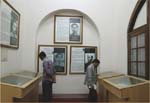Language Movement Museum in its infancy
 Written history is the main source for the younger generations to learn about the Language Movement and the Liberation War. Newspapers, television and films have had a great impact but archives or museums are the best way to display and preserve history. The Language Movement Museum is one such endeavour to inform succeeding generations about the historic event of 1952.
Written history is the main source for the younger generations to learn about the Language Movement and the Liberation War. Newspapers, television and films have had a great impact but archives or museums are the best way to display and preserve history. The Language Movement Museum is one such endeavour to inform succeeding generations about the historic event of 1952.
The museum embarked on its journey last year, primarily to focus on preservation of documents and memorabilia related to the movement. Prime Minister Sheikh Hasina inaugurated the museum — on the first floor of Bardhaman House (Bangla Academy) last year. The museum is spread over four rooms and is open seven days a week, from 3pm to 6pm; entry is free.
Though no curator has been appointed yet, Arifur Rahman, store officer of Bangla Academy, has been overseeing the care of the museum. He said that the academy has plans to extend the museum. He also informed that a significant number of people come here everyday to get a glimpse of history.
The museum has rare documents. The memorandum that was given to the then Governor General of Pakistan, Muhammad Ali Jinnah, by Rashtro Bhasha Karmo Parishad is on display. The memorandum highlights five points in favour of Bangla as the state language.
The address of welcome — containing demands for Bangla as the state language and the overall grievances of the then East Pakistan — to the then visiting Prime Minister Liakat Ali Khan by the students of Dhaka University is also at the museum. A couple of pages from the journal of Tajuddin Ahmed, written on February 21 and 22, 1952, have been showcased as well.
Covers of several books on the Language Movement are on display at the museum.
Photographs of the entire movement and its aftermath cover a wider spectrum at the museum.
A photograph shows the penultimate time of the movement, when students prepared at the historic Aamtala (near the Arts Faculty Building of Dhaka University) to break the Section 144 on February 21, 1952.
Several of the displayed photographs are by eminent researcher Professor Rafiqul Islam.
Photos along with brief bios of Language Movement martyrs Rafique, Jabbar, Salam and Barkat are also displayed at the museum.
Memorabilia such as sunglasses, bag and coat used by Shaheed Shafiur Rahman is on display as well. Shafiur Rahman was shot on Nababpur Road on February 22, 1952; he passed away that evening at Dhaka Medical College Hospital. He was awarded Ekushey Padak (posthumously) in 2000.
The museum is still in its infancy. However, it is an important step to archive many priceless documentaries related to the Language Movement. It is also a scope for youngsters as well as many individuals who want to delve deep into our national history.




















